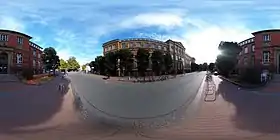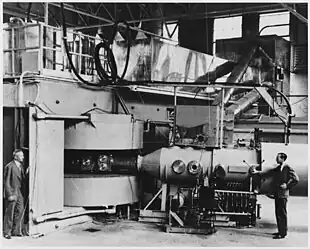Victor Ninov
Victor Ninov (Bulgarian: Виктор Нинов, born 27 June 1959) is a Bulgarian physicist and former researcher who worked primarily in creating superheavy elements. He is known for the co-discoveries of elements 110, 111, and 112 (darmstadtium, roentgenium and copernicium).
Victor Ninov | |
|---|---|
Виктор Нинов | |
| Born | 27 June 1959 |
| Alma mater | Technische Universität Darmstadt |
| Known for | Co-discoverer of elements 110, 111, and 112; alleged fabrication of the discovery of elements 116 and 118 |
| Scientific career | |
| Fields | Nuclear physics |
| Institutions | University of California, Berkeley |
| Thesis | Der gasgefüllte Separator als Separationsmethode zum Nachweis von Transuranen (1992) |
Ninov also claimed the creation of elements 116 and 118; however, an investigation concluded that he had falsified the evidence. The repercussions of that affair had an impact on the guidelines of conduct for several research institutions.
Early life
Victor Ninov was born in Bulgaria on 27 June 1959. He grew up in the capital city of Sofia.[1] In the 1970s, when Ninov was a teenager, he and his family left for West Germany; they bounced around from house to house.[2] Shortly after the move, Victor's father went missing; he was found dead six months later in the Bulgarian foothills due to causes unknown.[2]
Career

Victor Ninov attended Technische Universität Darmstadt near Frankfurt, Germany.[2][3] Here, he distinguished himself as a very capable physicist: he was particularly good at building scientific instruments and coding analysis programs for them.[2][4]
This landed him a job at the nearby German research center GSI (Helmholtzzentrum für Schwerionenforschung), where he worked on his doctorate and postdoctoral work of creating new elements.[2][5]
For his expertise, he was given sole control of the computer analysis program.[2] Here, he became a rising star by co-discovering darmstadtium (element 110), roentgenium (element 111), and copernicium (element 112) by smashing ion beams into heavy elements using GSI's UNILAC (a type of particle accelerator) and analyzing the debris.[2][4] Though an investigation later determined that these discoveries of element 110 and 112 included fabricated samples created by Ninov, additional evidence of the experiment was confirmed to be untampered with, rendering his co-discovery legitimate.[4][6] These discoveries were made with the help of his addition of a gas separator to the particle accelerator to help filter out everything but the heavy elements they were looking for.
He worked at Stanford University for a time.[1] He was hired at Lawrence Berkeley National Laboratory (LBNL) in 1996 as a world class expert for particle accelerator debris sensors, and analysis programs.[2]
Fraud investigation

While working at Lawrence Berkeley National Laboratory (LBNL) Victor Ninov and his team pursued a hypothesis by Robert Smolańczuk that element 118 could be formed at relatively low energies by smashing 86Kr and 208Pb isotopes together.[7][2] Ninov initially doubted the hypothesis he was pursuing; he is quoted as saying, "We didn't know how many orders of magnitude he [Smolańczuk] was wrong".[2]
As in some earlier research projects, Ninov held sole control of the data analysis program (LBNL's was called GOOSY), and he was the only one on the team who knew how to use it.[2] In 1999, Ninov and his team reported sightings of element 118, almost exactly as in Smolańczuk's hypothesis, and a decay chain that also produced element 116.[2][8][4][7] However, other laboratories were unable to reproduce the results.[9]
Eager to prove their discovery, the team double-checked their instruments, and tried again.[2] One more sighting was made by Ninov, but it was dismissed by a colleague, and a full formal investigation was held to find out what had happened.[2] The original element 118 data was independently analysed; in the original binary data, there was no indication of the presence of element 118 or 116.[2][8][4][7][9] The investigation dragged on for a year, until it was concluded that "Ninov... intentionally misled his colleagues—and everyone else—by fabricating data".[9]
Ninov, who had been placed on leave for the investigation, was fired.[2][4] The rest of Ninov's team officially retracted their claims in 2002.[8] There was also an investigation conducted into Ninov's previous unsupervised science at GSI; it was found that "two sightings were spuriously created" (one of element 110 and another of element 112).[4][6] However, very perplexingly, these false sightings were found amongst a large amount of real data that still supported his co-discoveries of elements 110 and 112.[4] The GSI investigation concluded that the discovery of those elements was legitimate.[4] Though particular details may remain unclear or controversial, at minimum it is certain that Victor Ninov made a "wrongful claim" about elements 116 and 118.[8]
The heavy elements 116 and 118 were eventually discovered and verified in the Joint Institute for Nuclear Research in Dubna, Russia, and their behaviour was not similar to the 1999 observations from LBNL.[9] These elements were named livermorium and oganesson respectively.[10][11] Ninov has continued to maintain that he was innocent.[2]
Impact on the scientific community
The reports of the investigation came as quite a shock to other scientists, as Ninov had previously been regarded as a very respected physicist.[2] In the aftermath of the investigation it was troubling to many that so many co-authors on LBNL's 1999 papers had contributed to a false statement while apparently unaware that it was false.[12] The Ninov affair resulted in stricter guidelines being set for coauthors; these rules "clarify co-authors' roles and duties" and include "requiring all coauthors to vouch for their contribution to published work".[12][13]
The American Physical Society has also called for increased ethical training and oversight at research institutions, and has sponsored several speakers in an effort to make the scientific community more comfortable and resilient to scientific fraud.[13] Reports on the Ninov affair were released around the same time as the final report on the Schön affair, another major incident of data falsification in physics, and this amplified its impact.[13]
Personal life
Ninov is retired from physics.[1] He currently lives in California.[1] His wife, Caroline Cox, a former history professor at University of the Pacific, died in 2014 of cancer.[1] They were married for 29 years.[1] Ninov had helped her finish her book, Boy Soldiers of the American Revolution, and it was published post-mortem.[1] He is an avid sailor, and pilots a four-seat plane.[1]
References
- Sauro, Tony (23 July 2016). "Final assignment: Family, friends and colleagues help complete late Pacific professor's book". recordnet. Retrieved 6 February 2023.
- Monastersky, Richard (16 August 2002). "Atomic Lies: How One Physicist May Have Cheated in the Race to Find New Elements". The Chronicle of Higher Education. Retrieved 16 April 2019.
- "Welcome to TU Darmstadt" [Darmstadt University of Technology]. Technische Universität Darmstadt. Retrieved 23 April 2019.
- Dalton, Rex (18 July 2002). "California lab fires physicist over retracted finding". Nature. 418 (6895): 261. Bibcode:2002Natur.418..261D. doi:10.1038/418261b. PMID 12124581.
- GSI Helmholtzzentrum für Schwerionenforschung (17 January 2012). "GSI - About us". www.gsi.de. Retrieved 23 April 2019.
- Hofmann, S.; Heßberger, F. P.; et al. (1 July 2002). "New results on elements 111 and 112". The European Physical Journal A. 14 (2): 147–157. Bibcode:2002EPJA...14..147H. doi:10.1140/epja/i2001-10119-x. S2CID 8773326.
- Seife, Charles (19 July 2002). "Heavy-element fizzle laid to falsified data. (Heavy-Ion Physics)". Science. doi:10.1126/science.297.5580.313.
- Schwarzschild, Bertram (September 2002). "Lawrence Berkeley Lab concludes that evidence of element 118 was a fabrication". Physics Today. 55 (9): 15–. Bibcode:2002PhT....55i..15S. doi:10.1063/1.1522199.
- Weiss, P (July 2002). "Heavy Suspicion". Science News. 162: 2 – via Academic Search Complete.
- Ninov, Viktor (1999). "Observation of Superheavy Nuclei Produced in the Reaction of 86Kr with 208Pb". Physical Review Letters. 83 (6): 1104–1107. Bibcode:1999PhRvL..83.1104N. doi:10.1103/PhysRevLett.83.1104.
- Johnson, George (15 October 2002). "At Lawrence Berkeley, Physicists Say a Colleague Took Them for a Ride". The New York Times.
- Park, Robert L (2008). "Fraud in Science". Social Research. 75 (4): 1135–1150. CiteSeerX 10.1.1.693.1389. doi:10.1353/sor.2008.0010. S2CID 141705050.
- Overbye, Dennis (19 November 2002). "After Two Scandals, Physics Group Expands Ethics Guidelines". The New York Times. ISSN 0362-4331. Retrieved 25 April 2019.
External links
- Observation of Superheavy Nuclei Produced in the Reaction of 86Kr with 208Pb – Communication in "Physical Review Letters" stating observation of the element 118 published by Victor Ninov's research group
- Sanacacio.net Copy of NY Times article on the Ninov controversy
- Atomic Lies An essay about V. Ninov's career